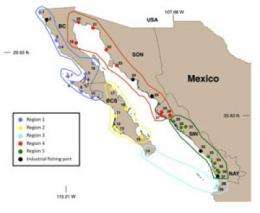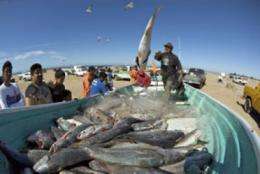Study finds common ground for ecosystems and fishing in Northwest Mexico

Researchers at Scripps Institution of Oceanography at UC San Diego have completed a new study on the geography of commercial fisheries in Northwest Mexico and the results could have far-ranging implications for the sustainable future of marine wildlife in the area.
The scientists, led by Scripps postdoctoral researcher Brad Erisman, analyzed data from local fisheries offices around the region that includes Baja California as well as Gulf of California coasts from Sonora south to Nayarit. The region accounts for more than 60 percent of fishing production in Mexico.
The scientists' goal was to detect any patterns between the geography of the species and their habitats in Northwest Mexico, and the localized fishing information revealed in the data. After poring over the data the researchers found clear-cut overlapping patterns in their analysis and used the results to create a new map proposing five clearly defined fishery sub-regions around Northwest Mexico.
While fisheries resources in Northwest Mexico are currently managed as one homogeneous area, the researchers' proposed sub-regions differentiate between areas rich in mangroves versus rocky shores, reefs versus soft sea bottoms, as well as temperate versus tropical regions, and geological features distinguishing west and east.
Such sub-regions, the researchers say, could be crucial for implementing specific, customized fishing and conservation practices, including so-called "ecosystem-based management" approaches in each region.

The map and results of the study were published in the International Council for the Exploration of the Sea's (ICES) Journal of Marine Science.
"We found a strong connection between geographic location of the major habitats of the region and the organization of the fishing activities in terms of what is being caught, whether it's clams, sharks or shrimp," said Erisman. "So this gives us a framework to operate both fisheries management and conservation priorities within the same region and on the same spatial scale, thus meeting criteria for maintaining healthy ecosystems and also for maintaining economic livelihoods and productive fisheries."
Erisman, Scripps postdoctoral researcher Octavio Aburto-Oropeza and their colleagues worked with landing records provided by Mexico's National Fisheries and Aquaculture Commission (CONAPESCA) and conduct detailed field surveys in the Gulf of California, spending several weeks in each expedition diving to document species and habitats and to speak with local fishermen about their practices.
Aburto-Oropeza says the data used in the study shed light on the economic importance of artisanal fishing practiced out of thousands of small panga boats in Northwest Mexico.
"Right now everything is managed the same way, with the idea of the largest-scale industrial fisheries of squid, tuna, shrimp and sardine," said Aburto-Oropeza. "But this study is showing that the small-scale fisheries and their landings of valuable species such as red snapper and snooks are very important. The management of the different regions in Northwest Mexico should be very different."

The sub-regions proposed by this study allow for the implementation of different management agendas such as networks of marine reserves and fisheries management plans.
For the idea to be effective, however, the researchers argue that large-scale industrial fishing activities that transect throughout Northwest Mexico would have to be curtailed. They also say the idea of customized sub-regions bolstering ecosystem-based management efforts could be applied in other areas of the world threatened by shrinking fisheries resources.
Provided by University of California - San Diego
















